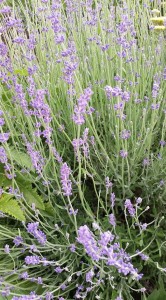Medicinal Herb Post #10 written June 7, 2018
Lavender – Lavendula officinalis (there it is again), L. angustifolia
Deep breath in… ahhhh! Everyone loves the smell of this hardy perennial including pollinators. It’s pretty easy to grow if you have well draining soil and full sun, but it will tolerate some partial shade too. It’s a bit difficult to start from seed so I let nature do that for me. Each year I usually get a baby plant close by the mother and transplant where I want it. Be sure to give each plant 2′ on either side as they can get large. It is a great drought tolerant plant as it does better with an occasional deep watering. The best time to harvest lavender is when there is the most amount of medicinal properties in the flower buds just before they open. You can still harvest open flower buds, but whatever you make just won’t be as strong. The leaves also have benefits. There are times I’ll run my hand through my lavender in the winter if there isn’t any snow and smell the calming fragrance. It’s a powerful aromatherapy plant.
Lavender relaxes the digestive tract making it useful for intestinal pain. It is also antiseptic and can help eliminate unwanted bacteria from the colon. Use with fennel seed for gas and indigestion. Lavender is a mild anti depressant and relieving to stress. I really like using it with milky oat tops, rose, skullcap and chamomile for stress.
It is fabulous for headaches, relieves stress, tension and insomnia. It also has antibacterial, antifungal, and antiseptic properties making it a good herb for respiratory infections and skin infections. I always keep a bottle of lavender essential oil in my first aid kit and purse. It’s one of the only essential oils safe enough to use directly on the skin. I’ve used it when hiking after a fall to clean/disinfect the wound before bandaging. It also decreases scaring. When we have been out in the sun a little too long I’ll dilute some of the essential oil in water and spray on the effected area. The immediate cooling relief is a welcome one! It also relieves pain from other types of burns and bee stings/bug bites.
I really like the headache tincture I make with equal parts lavender, chamomile and feverfew. It’s even great for migraines. You can also add California poppies as they are also good for pain. You can use vodka, apple cider vinegar or half glycerine/half purified water to cover the herbs and shake each day for a month. Strain and keep in an amber bottle. Take 1/4 – 1/2 tsp every 20-30 minutes for up to 2 hours. Don’t use during menstruation because of the feverfew as it can increase bleeding.
I also make a sleepy time tincture using equal parts lavender, valerian root, hops, chamomile and lemon balm. Works like a charm for insomnia and turning off a busy mind without any drousy side effects. My husband loves it!
Lavender should not be used internally during pregnancy in large amounts because it can stimulate the uterus.
I’m going to try using my infused lavender oil to make a lotion. Here’s the recipe:
.5 oz. beeswax
4 oz lavender infused oil (steep lavender buds in olive oil, almond oil or grape seed oil for 2 weeks in the sun or on the stove top on really low heat for 40 -50 minutes)
4 oz rose infused water (soak rose petals in purified water over night)
10 drops vitamin e oil
5 – 10 drops lavender essential oil
Melt wax and oil together on low heat. Mix together the rose water, vitamin e and essential oil in a separate bowl. Pour the water mixture slowly into the oil off the heat and use an immersion blender to emulsify the ingredients until thick and creamy. Put in jar and use within 6 months.
We’ve also made infused massage oil with the lavender and put it in soap. So many fun things to do with it!
What do you use your lavender for?

